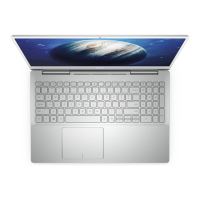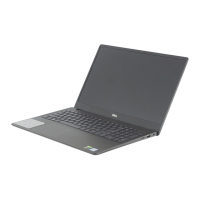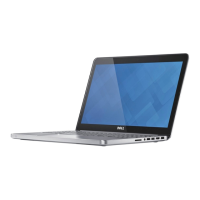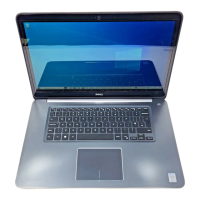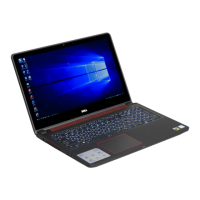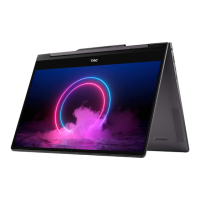What to do if Dell Laptop system board fails during M-BIST?
- DDerek JacksonJul 27, 2025
If the system board fails during M-BIST, you should replace the system board to fix the issue.
What to do if Dell Laptop system board fails during M-BIST?
If the system board fails during M-BIST, you should replace the system board to fix the issue.
Explains the meaning of notes, cautions, and warnings used in the manual for user guidance.
Provides initial steps and considerations before disassembling the computer for service.
Outlines critical safety guidelines for handling the computer and its components to prevent damage.
Details measures to prevent damage from static electricity when handling sensitive electronic components.
Describes the components and use of the ESD field service kit for safe hardware handling.
Instructions for reassembling and powering on the computer after service procedures are completed.
Lists the essential tools required for component removal and installation procedures in the manual.
Details the types, quantities, and securing locations of screws used throughout the system.
Details the process for removing and installing the computer's base cover.
Covers precautions and procedures for handling the lithium-ion battery.
Step-by-step guide for removing and installing the 3-cell battery.
Step-by-step guide for removing and installing the 6-cell battery.
Instructions for removing and installing the Wireless Local Area Network (WLAN) card.
Guide for removing and installing memory modules in the single slot configuration.
Procedure for removing and installing the M.2 2280 SSD in slot 1.
Procedure for removing and installing the M.2 2230 SSD in slot 1.
Steps for replacing the support bracket for the M.2 SSD in slot 1.
Procedure for removing and installing the M.2 2280 SSD in slot 2.
Instructions for removing and installing the computer's internal speakers.
Guide for removing and installing the Graphics Processing Unit (GPU) fan.
Steps for removing and installing the computer's system fan.
Procedure for removing and installing the UMA (Unified Memory Architecture) heat sink.
Procedure for removing and installing the discrete heat sink.
Instructions for removing and installing the coin-cell battery.
Steps for removing and installing the Input/Output (I/O) board.
Guide for removing and installing the power button and fingerprint reader assembly.
Instructions for removing and installing the DC-in power port.
Steps for removing and installing the laptop's touchpad.
Guide for removing and installing the entire display assembly.
Detailed steps for removing and installing the main system board.
Instructions for removing and installing the palm-rest and keyboard assembly.
How to access and navigate the BIOS setup utility.
Explains the keyboard keys used for navigating within the BIOS setup menu.
How to configure the order in which the computer searches for bootable devices.
How to access a menu to select a boot device for a single startup.
General overview of the BIOS setup options and their purposes.
Options for configuring the system's boot order and secure boot settings.
Settings for enabling or disabling built-in hardware components like camera and audio.
Configuration settings for SATA operation, storage interfaces, and SMART reporting.
Settings to control screen brightness, touchscreen functionality, and display logos.
Settings for wireless devices and network stack configuration.
Options to manage battery health, peak power usage, and thermal performance.
Options for controlling system security, including Intel SGX, PTT, and TPM.
Settings for managing admin, system, and hard drive passwords.
Options for updating BIOS firmware and recovering the system from issues.
Information regarding service tags, asset tags, and auto-on time settings.
Options for NumLock, Fn Lock, keyboard illumination, and backlight timeouts.
Settings that affect the system's behavior during the pre-boot and boot processes.
Options for controlling multi-core support, CPU speed, and power states.
Options for viewing and clearing BIOS, Thermal, and Power event logs.
Overview of diagnostic tests to check system board and display functionality.
Detailed steps for performing the M-BIST diagnostic on the system board.
Explains the L-BIST test for checking power to the LCD panel.
Details the LCD-BIST test for verifying display functionality through color patterns.
Information on using Dell's hardware diagnostic tool for comprehensive system checks.
Explains the meaning of system status indicators, particularly the battery-status light.
Guidance on using Dell SupportAssist OS Recovery to restore the system.
Instructions for updating the system's BIOS via the Dell support website.
Procedure for updating the BIOS using a bootable USB drive.
Recommendations for creating recovery media for Windows.
Steps to resolve internet connectivity issues by cycling power on network devices.
Links and information for accessing Dell's online support and knowledge base.
Information on how to contact Dell for sales, technical support, or customer service.
| Operating System | Windows 10 Home or Windows 10 Pro |
|---|---|
| Webcam | 720p at 30 fps HD camera |
| Audio | Stereo speakers with Waves MaxxAudio Pro |
| Processor | 10th Generation Intel Core i7-10750H |
| Display | 15.6-inch FHD (1920 x 1080) |
| Graphics | NVIDIA GeForce GTX 1650 Ti with 4GB GDDR6 |
| RAM | 8GB or 16GB DDR4, 2933MHz |
| Storage | 512GB M.2 PCIe NVMe Solid State Drive |
| Ports | 1x HDMI 2.0, 1x SD card reader, 1x headphone/microphone combo jack |
| Wireless | Bluetooth 5.1 |
| Dimensions | 356.1 mm |
| Weight | 1.75 kg (3.86 lbs) |


